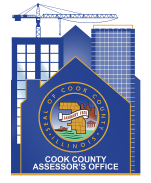Calculating an Estimated Residential Property Tax Bill

The Cook County Assessor is responsible for determining the first part of the equation used by the Cook County Treasurer to calculate your property taxes. The Assessor does not set tax rates
or levies or decide the dollar amount of your tax bill. He determines only a "Market Value" (MV) for your property and, for taxation, uses 10% of its value as the "Assessed Valuation" (AV).
The State Equalization Factor/Multiplier ("State Equalizer") is then applied to the AV, and this creates the Equalized Assessed Value (EAV) for the property. After any qualified property tax exemptions are deducted from the EAV, your local tax rate
and levies are applied to compute the dollar amount of your property taxes. Please remember: each Tax Year's property taxes are billed and due the following year. For instance, 2018 taxes are billed and due in 2019.
If you believe your home's Assessed Value should be lower, Cook County Assessor Fritz Kaegi encourages you to file an appeal. Homeowners do not need an attorney to appeal and there is no fee involved. Assessor Kaegi has streamlined the appeal process and made it easier, more transparent and open. He believes your appeal is an important step in ensuring that no one pays more than his or her fair share of property taxes.
Property tax bills are mailed twice a year. Your first installment is due at the beginning of March. By law, the First-Installment Property Tax Bill is exactly 55% percent of the previous year's total tax amount. The Second-Installment Property Tax Bill is mailed and due in late summer; it reflects new tax rates,
levies, assessments and any dollars saved by exemptions for which you have qualified and applied.
The following is an example of how an estimated tax bill is calculated.
Please note the Equalized Assessed Value (EAV) is the partial value of your property. It is the figure on which your tax bill is calculated. Also note that exemptions are deducted from the EAV, which will likely lower your tax bill. The exemption amount is
not the dollar amount by which your tax bill could be lowered.
[Figures are approximate, based on samples of MV, EAV and a local Tax Rate.
the State Equalizer shown is current until May 2020]
| $100,000 |
|
Estimated Market Value |
| X.10 |
|
Assessment Level (10%) |
| $10,000 |
|
Proposed Assessed Valuation |
| X 2.9109 |
|
State Equalizer |
| $29,109 |
|
Equalized Assessed Value |
| -10,000 |
|
Homeowner Exemption( **new increased exemption amount) |
| $19,109 |
|
Adjusted Equalized Assessed Value |
| X.10 |
|
Sample Tax Rate (your tax rate could vary) |
| $1,910.90 |
|
Estimated Tax Bill in dollars |

**Please Note: A new law expands the Homeowner Exemption savings this year from $7,000 to $10,000 in Equalized Assessed Value (EAV). It is important to note that the exemption amount is not the dollar amount by which a tax bill is lowered. EAV is the partial value of a property to which tax rates are applied; it is this figure on which a tax bill is calculated.
The new law also expands the Senior Exemption savings, for taxpayers/residents 65 years or older, regardless of income. It increased from $5,000 to $8,000 in EAV.
A Homeowner Exemption is calculated by multiplying the Homeowner Exemption savings amount ($10,000) by your local tax rate. A Senior Exemption is calculated by multiplying the Senior Exemption savings amount ($8,000) by your local tax rate. Your local tax rate is determined by the Cook County Clerk and can be found on your second-installment tax bill or by contacting the Cook County Clerk’s Office at 312- 603-6566.
